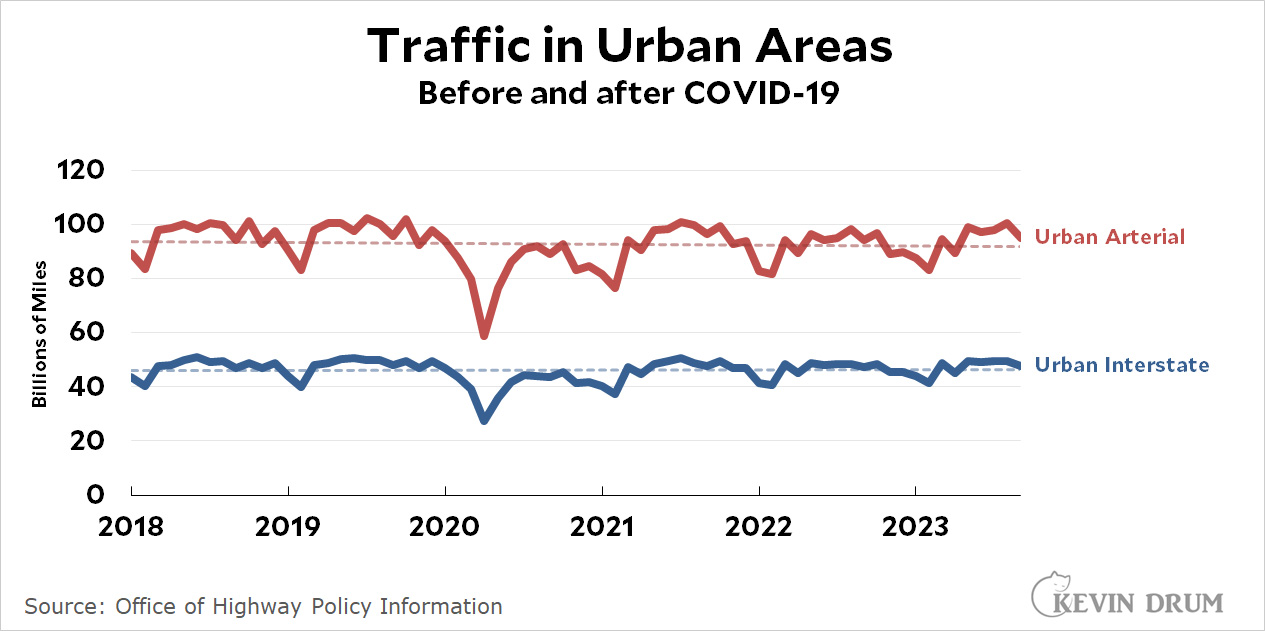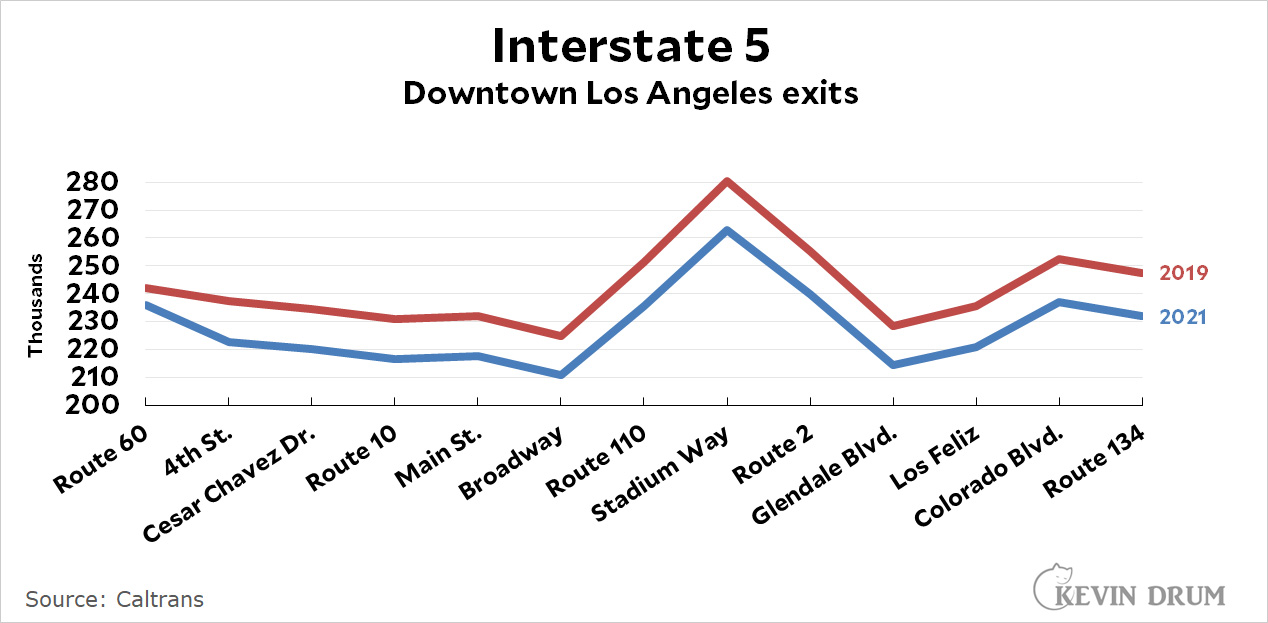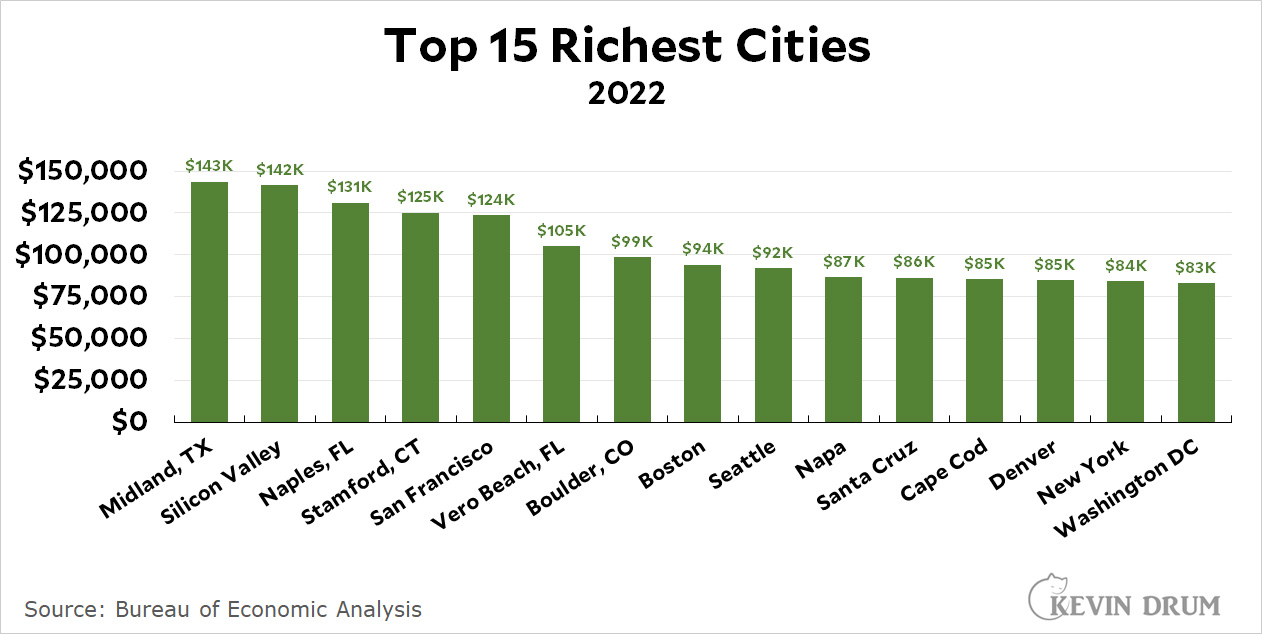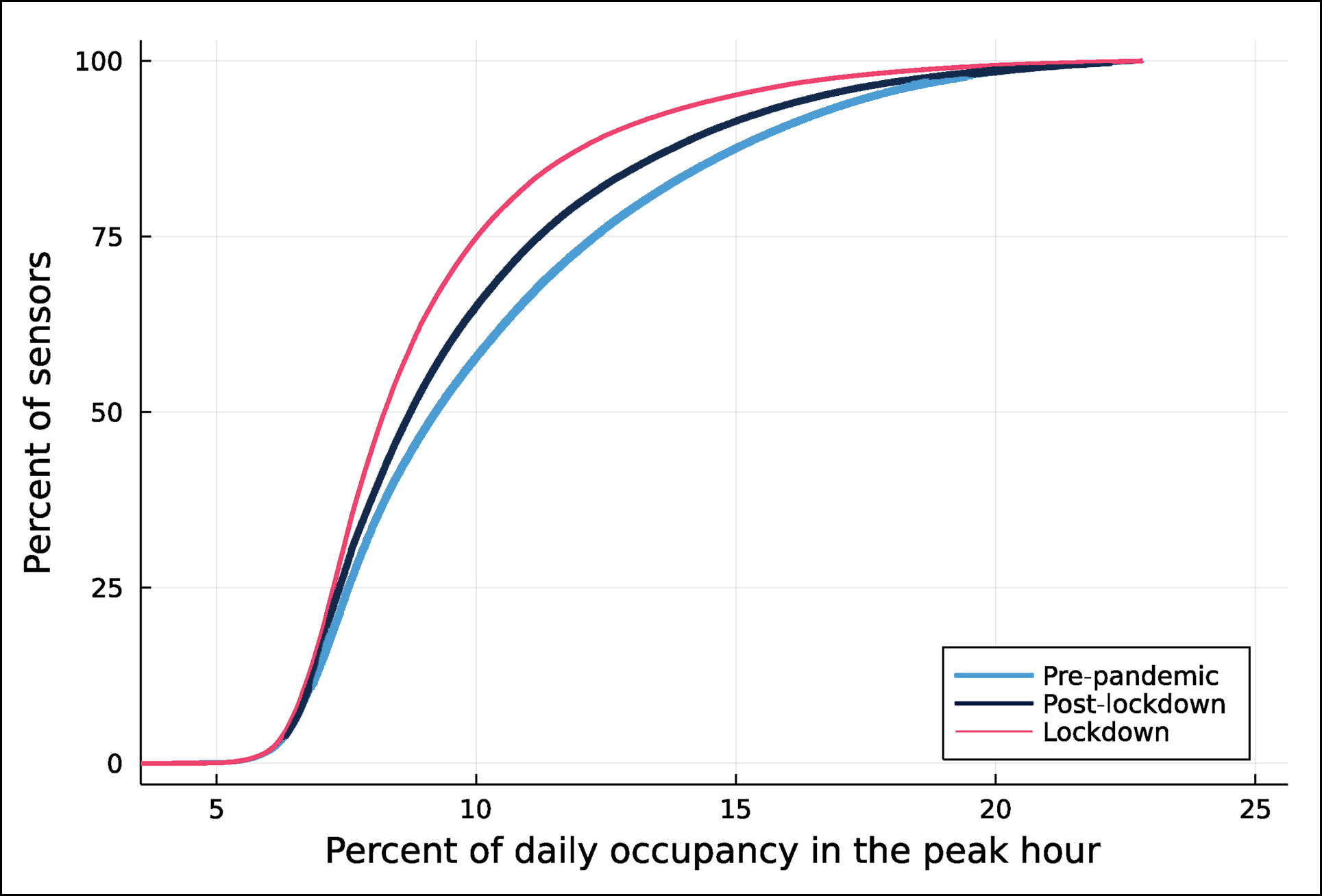In 2022, the richest city in America was Midland, TX. The poorest city was McAllen, TX. Texas is truly a land of contrasts.
Month: November 2023
Childhood vaccination rates have remained low this year
NOTE: This post has been corrected.
Kiera Butler reports today that since the pre-pandemic era the overall childhood vaccination rate has fallen from 95% to 93%:
Childhood Vaccination Rates Are Declining. You Can Blame MAGA.
This latest development is no random statistical blip—actually, I’ve been dreading it for a while now. What started as a campaign by a small group of influencers who exist in the nexus of wellness culture and rightwing politics has entered the national conversation as a major talking point of powerful conservative politicians.
As usual, this got me curious: can we blame MAGA? The CDC reports vaccination rates by state, and it's easy enough to plot this against each state's vote for Donald Trump in 2020:
 The regression line does show a slight correlation between vaccination rates and Trump vote, but the trendline fit is lousy. It may slope downward slightly, but it doesn't mean much.
The regression line does show a slight correlation between vaccination rates and Trump vote, but the trendline fit is lousy. It may slope downward slightly, but it doesn't mean much.
So I tried something else. Here's the same kind of plot, but this time for vaccine exemptions requested by parents:
 Once again, there's a slight correlation with Trump voters, but once again the trendline fit is lousy. It really doesn't mean anything.
Once again, there's a slight correlation with Trump voters, but once again the trendline fit is lousy. It really doesn't mean anything.
So can we blame MAGA for the decline in childhood vaccination rates? Maybe slightly, but it doesn't really look like it. Note, however, that plotting this on a state basis runs the risk of getting the wrong result via the ecological fallacy. Maybe someone with fancier tools will take a closer look at this.
Raw data: Urban traffic pre- and post-COVID
Today at lunch the topic of traffic came up. If lots of people are working at home these days, shouldn't commuting traffic in cities be down considerably? I said I'd check, but that turns out not to be easy. Here's one data point:
 This is national data and it shows no change whatsoever in urban traffic before and after the pandemic.
This is national data and it shows no change whatsoever in urban traffic before and after the pandemic.
Next I headed over to Caltrans to see what kind of data they had for Los Angeles. Lots, it turns out, but only through 2021. Still, that would be suggestive, so I pulled up all the downtown LA exits from Interstate 5:
 The year 2021 was a peak for remote work, but traffic was down only 6%.
The year 2021 was a peak for remote work, but traffic was down only 6%.
This gibes with personal experience: namely that rush hour traffic seems just as jammed today as it was a few years ago. But is it really? Apparently so. Here is Martin Morzynski, an executive at Streetlight, a traffic analytics firm:
Despite empty offices, rush hour congestion is back, with key streets leading in and out of our downtowns clogged again.
A recent study of California traffic suggests that although overall volume is nearly back to normal, peak travel has been spread out:
During the pre-pandemic peak hour, the occupancy during the peak hour is high, indicating congestion....Post-lockdown, spreading of the peaks has somewhat decongested rush hour. Even though the peaks have spread out, the reduction of gridlock has enabled a larger portion of daily vehicles to successfully transit the intersection during the peak hour.
I'm a little baffled about what this chart shows, but one thing is obvious: there's not a big difference between pre-pandemic and now. The authors claim that the share of traffic occurring at peak hours is down from 10.3% to 9.8%, but they themselves are a bit puzzled by this, since it's not clear why peak traffic should be down if total traffic has stayed the same.
Overall, the evidence suggests that urban traffic has barely changed since before the pandemic, despite the fact that the occupancy rate of downtown office towers has plummeted to around 50%. This is a considerable mystery. If lots of people are staying home instead of commuting to those towers, why hasn't traffic subsided?
Please leave a tip if you read this blog post
An op-ed in the Washington Post today complains about all those touchscreen apps asking how much of a tip you want to leave:
Tipping is now out of control. Gratuity prompts have become so widespread and indiscriminate that a new study from the Pew Research Center shows it is causing mass confusion and frustration.
....The easy-to-tap buttons for 10, 15, 20 percent — in Los Angeles, often 30 percent! — have put tipping on autopilot. It may spare us the awkward math, but it also erases the pause for appreciation. The presence of a watchful employee has turned the act of tipping, even for subpar or no service, into a reflex rather than a reflection. We often tip simply to end the transaction, and businesses bank on that.
I've heard this complaint before and I don't get it. I don't consider these screens to be a demand for a tip, just a routine thing at places that run partly on tips. If my transaction isn't the kind of thing I'd normally tip for, I just press "No Tip" and finish up. Is that really so hard?
But maybe I'm just heartless. How about the rest of you? Do you find these screens sort of intimidating, as if you're expected to tip in every conceivable situation these days?
Lunchtime Photo
Republicans still unable to pass anything
Republicans: can't live with 'em, can't chop 'em up for cat food:
For review, since Johnson took over as speaker, House Republicans have:
Yanked THUD from the floor
Yanked FSGG from the floor
Voted down a rule on CJS
Had 93 no votes on a clean CR
Still no action on AG
Appear to be stalled on Labor-HHSNow there are two spending deadlines in… https://t.co/9UlaAHyPsu
— Jake Sherman (@JakeSherman) November 15, 2023
For those of you who don't follow acronyms closely:
- THUD = Transportation + Housing and Urban Development
- FSGG = General government
- CJS = Commerce + Justice + Science
- AG = Agriculture
- Labor-HHS = Labor + Health and Human Services
Republicans haven't made progress on any of the other appropriations bills either, so in a way there's hardly any point in highlighting just these. They can't do anything.
What’s the deal with Tether?
Zeke Faux's account of the crypto industry, Number Go Up, is a great book. But there's an odd thing about it: The genesis of Faux's interest in crypto is Tether, a so-called "stablecoin" that's always equal to exactly $1 and is backed 1:1 by currency and safe securities. Faux wants to learn more about Tether—for example, is it really backed 1:1 by dollars?—but is unable to do so. By the end of the book he's as much in the dark as ever. He's unable to interview anyone at Tether. No audits are available. Its finances are hazy. And its executives stay mostly out of sight.
And yet, Tether is the foundation of the entire crypto market. When people trade crypto, they mostly buy Tether and then trade the Tether for whatever coins they want. Since 2019, the amount of Tether in circulation has increased from roughly zero to nearly $90 billion:
 I'm not sure why this popped into my brain today, but I was always a bit mystified that Faux, who spent a great deal of time investigating crypto, was literally unable to find out anything about Tether. Nor is Tether regulated, since it's a non-US corporation. It's basically a bank with $90 billion in assets but no need to tell the world if it really has the reserves to back up that $90 billion if it were subject to a run.
I'm not sure why this popped into my brain today, but I was always a bit mystified that Faux, who spent a great deal of time investigating crypto, was literally unable to find out anything about Tether. Nor is Tether regulated, since it's a non-US corporation. It's basically a bank with $90 billion in assets but no need to tell the world if it really has the reserves to back up that $90 billion if it were subject to a run.
Anyway, that's it. I don't have anything to add to the immense abyss of non-information about the most important cryptocurrency in the world. It's just very strange, that's all.
America is the envy of the world
There is, I suppose, not much point in trawling the internet every morning and arguing with random conservative posts. But sometimes I just shake my head and can't help myself. Here is Jimmy Quinn, national security correspondent for National Review:
There’s a lot to say about the implications of the Biden administration’s apparent return to a version of the old policy of engagement with Beijing. As Xi receives a warm welcome in the Bay Area, it’s worth referring back to what Senator Marco Rubio said in November of 2020 as the senate prepared to vote on then-president-elect Biden’s nominees: “Biden’s cabinet picks went to Ivy League schools, have strong resumes, attend all the right conferences & will be polite & orderly caretakers of America’s decline.”
Two things. First, Joe Biden has been tougher on China than any American president in recent memory. What do Quinn and folks like him want? Is a single meeting that's relatively neutral really enough to throw them into a tizzy?
Second, in what way has America declined? I don't mean, "What stuff has happened you disagree with?" Everyone, everywhere, for all time has had a list of that. I mean, "What evidence do you have of any decline in American power or prosperity?" Our economy is outpacing everyone in the world. Our military is unmatched and we've led the world in building an alliance against Russia's aggression in Ukraine. The dollar remains mighty. Our universities are still the best in the world. We're a net oil and gas exporter. Entrepreneurism is booming and no other country comes close to matching us. Donald Trump is no longer president. We're world leaders in artificial intelligence, the most important technology of the next few decades.
So what's the problem? Some annoying wokeism? A few too many illegal immigrants—which we probably need anyway? Too many opioid deaths? With all due respect, this stuff is small potatoes. On the big issues we're the envy of the world, and with good reason.
Retail sales were down slightly in October
Adjusted for inflation, retail sales were down 2.5% in October:
PPI eases substantially in October
The Producer Price Index dropped substantially in October:
 This is good inflation news. It's a volatile series, but on a trend basis PPI is down to 0%. Even the PPI for services was down to 0%.
This is good inflation news. It's a volatile series, but on a trend basis PPI is down to 0%. Even the PPI for services was down to 0%.
On a conventional year-over-year basis, PPI in October clocked in at 1.3%.





